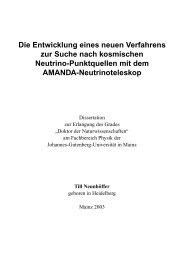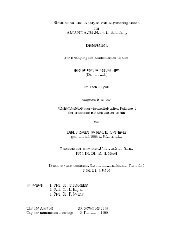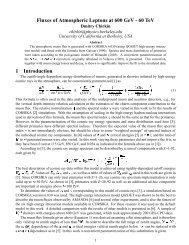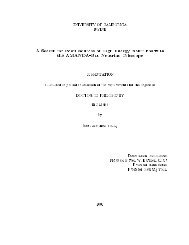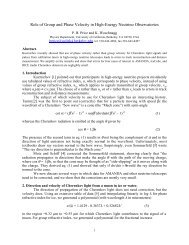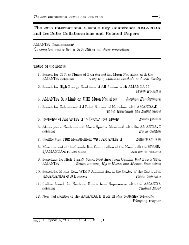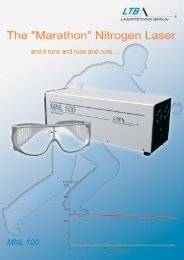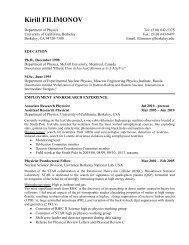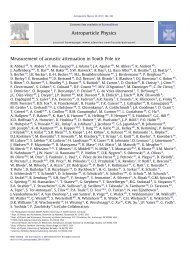Link to Fulltext
Link to Fulltext
Link to Fulltext
Create successful ePaper yourself
Turn your PDF publications into a flip-book with our unique Google optimized e-Paper software.
But the expression in Eq. 50 does not correspond <strong>to</strong> a properly normalized probability distribution.<br />
Integrating the formula over all ’s yields the normalization:<br />
<br />
<br />
¢<br />
© ¡ ¢<br />
<br />
<br />
<br />
£<br />
¦<br />
<br />
<br />
and we get the properly normalized probability distribution function:<br />
<br />
<br />
<br />
© <br />
<br />
© £<br />
¦<br />
¡ <br />
© <br />
¢<br />
¡ ¢ ¢©<br />
<br />
Another way of reaching this result is by noticing that the derivation of the p.d.f. in Eq. 50 assumes<br />
that we actually observe a hit. Dividing it by the © <br />
probability <strong>to</strong> have at least one<br />
hit, we get the conditional p.d.f. in Eq. 52.<br />
If the number of pho<strong>to</strong>ns is Poisson distributed, then the number of pho<strong>to</strong>electrons is Poisson<br />
<strong>to</strong>o [60]. In reality, the PMs record pho<strong>to</strong>electrons, so their expectation value is the number of<br />
pho<strong>to</strong>ns hitting the cathode, times the quantum efficiency ¢ of the PM. Thus, the formula in<br />
Eq. 52 can be used, replacing by <br />
and replacing by the Green’s function given<br />
<br />
¦<br />
by Eq. 45.<br />
This distribution has been tested by fitting time distributions taken with high intensity<br />
pulses [23], yielding absorption and scattering lengths compatible with previous analyses. It is<br />
useful where there are no reliable measurements of hit intensities and the only data available are<br />
the hit times. An analysis of electron neutrino induced cascades in AMANDA-A has been made,<br />
making use of a more sophisticated version of Eq. 52 in a reconstructing algorithm of cascades.<br />
It resulted in limits put on the ¡ flux at energies greater than ¡ GeV [61].<br />
5.2 The ice at AMANDA-B depths<br />
Calibration-data from AMANDA-B4 have also been analyzed, yielding much narrower time distributions<br />
than AMANDA-A (see Fig. 28). This is in agreement with the increase in scattering<br />
length with depth measured in AMANDA-A. Indeed, by extrapolating the curve in Fig. 27 <strong>to</strong><br />
0, the disappearance ¥ of air bubbles can be predicted below 1200 m, whereas the shallowest<br />
AMANDA-B4 modules is located at 1520 m depth. The remaining time delays in the distributions<br />
are believed <strong>to</strong> be caused by scattering on dust particles. Preliminary Monte Carlo simulation<br />
comparisons indicated a scattering length so long that the assumption of diffusion could<br />
not hold anymore. A Green’s function could not be derived<br />
<br />
for<br />
© <br />
the range of optical parameters,<br />
¡ ¡<br />
where (i.e. of the order of the distance between <br />
strings) and . Instead of<br />
relying on an analytical formula, the optical parameters of the ice between 1520-2000 m had <strong>to</strong> be<br />
extracted from the data by fitting distributions with different absorption and scattering lengths<br />
<strong>to</strong> it. Two statistical methods were used: the<br />
<br />
Kolmogorov-Smirnov<br />
<br />
test<br />
<br />
and<br />
<br />
a<br />
© <br />
straightforward<br />
¡ ¡<br />
-minimization. The first yielded and using both calibration <br />
data<br />
taken with the 337 -laser module from UCB at 1830 m depth and light sent from a YAG-<br />
<br />
laser from the surface through optical fibers ending at different<br />
£<br />
nm¤<br />
levels, assuming an isotropic light<br />
source in both cases. In the latter, pulses of light in the range 475-515 nm could be produced in<br />
situ.<br />
The second method was applied on the -laser module data, with the improvement that<br />
the source was simulated more correctly, as a distribution covering §<br />
sr and pointing upward<br />
[63]. The orientation of the receiving OM was also taken in<strong>to</strong> account. An example of such<br />
<br />
<br />
<br />
¦<br />
© <br />
40<br />
(51)<br />
(52)



